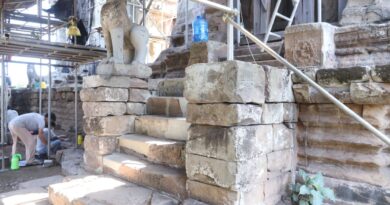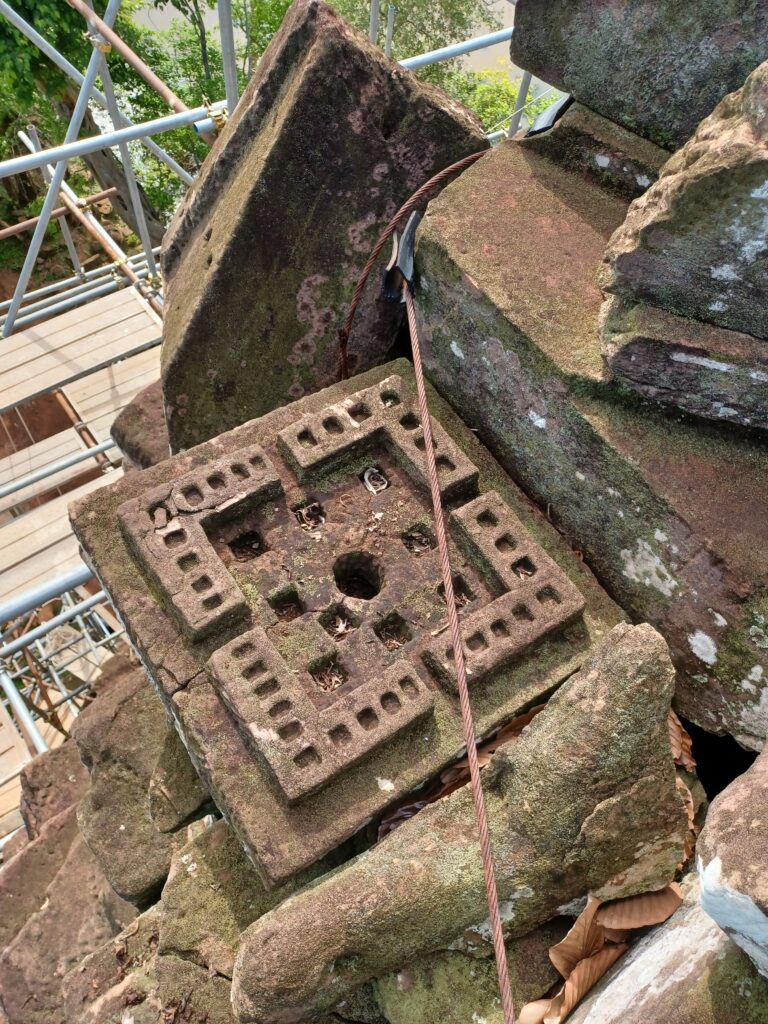ថ្មភក់រាងបួនជ្រុង ទំហំ៥៣សង់ទីម៉ែត្រ គុណនិង ៥៣សង់ទីម៉ែត្រ និងកម្រាស់ ១២សង់ទីម៉ែត្រ ដែលគេស្គាល់ជាទូទៅថាជា «ថ្មបញ្ចុះសីមា» ត្រូវបានរកឃើញទើនៅលើខ្លោងទ្វារពេលរុះរើផ្នែកខាងលើនៃរចនាសម្ពន្ធសំណង់ខ្លោងទ្វារតាកាវដើម្បីជួសជុល។ នៅលើថ្មបញ្ចុះមានរន្ធជាច្រើន ដែលរន្ធរាងមូលធំមួយនៅចំកណ្តាលនៃផ្ទៃថ្មព័ទ្ធជុំវិញដោយរន្ធរាងបួនជ្រុងស្មើនៅតាមទិសទាំង៨ និងនៅជ្រុងឦសានដែលជាទិសសំខាន់នៅក្នុងជំនឿខ្មែរតាំងពីបុរាណកាលរហូតដល់បច្ចុប្បន្ន ត្រូវបានគេដាប់រន្ធបួនជ្រុងបន្ថែមមួយទៀតនៅចន្លោះរន្ធមូលកណ្តាល និងរន្ធបួនជ្រុងនៅទិសឦសាន។ រន្ធទាំងអស់ព័ទ្ធពីក្រៅដោយជញ្ជាំងថ្មភក់ ដែលជញ្ជាំងនេះត្រូវបានកាត់ផ្តាច់ចេញជា៤ជ្រុងដោយចង្អូរនៅតាមអ័ក្សសំខាន់ទាំងបួន។ នៅពីលើផ្នែកខ្ពស់មានរន្ធតូចៗ រាងបួនជ្រុងចំនួន៣៤ ដែលគេដាប់រាក់ល្មមចំនួន១០នៅជ្រុងឦសាន ៩នៅជ្រុងអាគ្នេយ៍ ៧នៅជ្រុងនិរតី និង៨នៅជ្រុងពាយ័ព្យ។
ឯកឧត្ដម គឹម សុធិន អគ្គនាយករង នៃអាជ្ញាធរជាតិអប្សរា បានមានប្រសាសន៍ថា ថ្មបញ្ចុះសីមាភាគច្រើនប្រទះឃើញនៅកណ្ដាលបាតប្រាសាទ ប៉ុន្តែ វាច្រើនមានកម្រាស់ក្រាស់ និងដោយនៅផ្នែកខាងលើកំពូលគឺស្ដើងដូចថ្មដែលបានរកឃើញ។ ឯកឧត្ដម បានប្រៀបធៀបជំនឿ និងទំនៀមទម្លាប់នៃការបញ្ចុះថ្មសីមា ទៅនិងសំណង់ផ្ទះលំនៅដ្ឋានខ្មែរជាមួយនឹងការចងក្រណាត់ពណ៌ក្រហម(យ័ន្ត)នៅចំកណ្តាលមេដំបូលដែលទើបតែសាងសង់ថ្មីដើម្បីការពារផ្ទះផងដែរ។ ឯកឧត្តម មានប្រសាសន៍ថា ថ្មបញ្ចុះ ដែលរកឃើញនៅពេលជួសជុលត្រូវបានបញ្ចុះកាលដើមឡើយនៅលើកំពូលប្រាង្គកណ្តាល ប៉ុន្តែ វាបានរលុះធ្លាក់មកទើរនៅពាក់កណ្តាលនៃខ្លោងទ្វារ។ ក្រៅពីការបញ្ចុះថ្មដែលមានរន្ធច្រើននៅកំពូលប្រាសាទ គេបានឃើញថ្មបញ្ចុះស្រដៀងគ្នានៅក្នុងគ្រឹះប្រាសាទមួយចំនួននៅតំបន់អង្គរ។ ការបញ្ចុះថ្មទាំងអស់មិនថាតែនៅក្នុងគ្រឹះ និងលើកំពូលប្រាសាទ គឺនឹងធ្វើឱ្យសំណង់ដែលកំពុងសាងសង់មានភាពរឹងមាំ ព្រមទាំងនាំមកនូវសេចក្តីសុខ និងសេចក្តីចម្រើនដល់សំណង់។ ថ្មបញ្ចុះ គឺជាពាក្យដែលយើងប្រើបច្ចុប្បន្ន តែពាក្យដែលប្រើដើម្បីហៅថ្មសម្រាប់បញ្ចុះឱ្យបានត្រឹមត្រូវតាមក្បួនបុរាណហាក់ដូចជាមិនទាន់ប្រទះឃើញសរសេរនៅក្នុងឯកសារណាមួយនៅឡើយ។
ឯកឧត្ដម បានមានប្រសាសន៍ទាក់ទងនឹងរន្ធនៅលើថ្មបញ្ចុះវិញថា រន្ធតូចៗប្រើសម្រាប់ដាក់សន្លឹកមាសស្ដើង ហើយរន្ធមួយធំនៅចំកណ្ដាលប្រើសម្រាប់ដាក់ដងបង្គោលត្រីសូល៍ ដូចឃើញមាននៅចម្លាក់ប្រាសាទបាយ័ន្តស្រាប់។ យើងពិនិត្យឃើញថា កំពូលប្រាសាទបាយ័ន្តបានបាត់ត្រឹមផ្កាឈូក និងមានសេសថ្មខ្លះៗដែលជាទម្រឬសសីមាប៉ុណ្ណោះ
ឯកឧត្ដម បានកត់សម្គាល់ថា ជាការរុះរើដោយមនុស្សរករបស់មានតម្លៃ។ បច្ចុប្បន្ន យើងបានលើកយកថ្មបញ្ចុះទៅដាក់នៅលើកំពូលប្រាង្គកណ្តាលនៃខ្លោងទ្វារតាកាវវិញក្រោយពីបានពង្រឹងកន្លែងពុកផុយ និងជួសជុលកន្លែងប្រេះបែករួចរាល់។ ការរកឃើញថ្មបញ្ចុះនៅកំពូលប្រាសាទនេះមិនមែនជាលើកដំបូងទេនៅក្នុងតំបន់បេតិកភណ្ឌពិភពលោក-អង្គរ ព្រោះកាលពីពេលកន្លងមក គេធ្លាប់បានរកឃើញថ្មបញ្ចុះដែលមានទម្រង់ផ្សេងៗ ដែលវិវឌ្ឍទៅតាមសម័យកាលនៅប្រាសាទដំរីក្រាបលើភ្នំគូលែន ប្រាសាទបន្ទាយស្រី ប្រាសាទបន្ទាយក្តី និងប្រាសាទទន្លេស្ងួតជាដើម។ បច្ចុប្បន្ន យើងបានលើកយកថ្មបញ្ចុះទៅដាក់នៅលើកំពូលប្រាង្គកណ្តាលនៃខ្លោងទ្វារតាកាវវិញក្រោយពីបានពង្រឹងកន្លែងពុកផុយ និងជួសជុលកន្លែងប្រេះបែករួចរាល់។
គួរបញ្ជាក់ផងដែរថា គម្រោងជួសជុលខ្លោងទ្វាតាកាវនេះឧបត្ថម្ភដោយលោកជំទាវ ឧញ៉ា សៀង ចាន់ហេង អគ្គនាយិកាក្រុមហ៊ុនហេងអភិវឌ្ឍន៍។ លោកជំទាវតែងតែចូលរួមឧបត្តម្ភដល់សកម្មភាពថែរក្សា និងអភិរក្សតំបន់រមណីយដ្ឋានអង្គរ មានជាអាទិ៍ ការជួសជុលរហាត់ទឹក ការជួសជុលប្រាសាទស្រះស្រង់ និងការជួសជុលខ្លោងទ្វារតាកាវនេះ៕
អត្ថបទ៖ កញ្ញា ឆាយ ផាន់នី
រូបភាព៖ ក្រុមការងារជួសជុសខ្លោងទ្វារតាកាវ
The ancient stone slab found at the top of Angkor Thom’s Takav Gate
A sandstone measuring 53 cm by 53 cm and 12 cm thick, commonly known as “boundary stone”, was found on the Takav Gate when the upper part of the gate structure was dismantled for restoration work. On the stone slab, there are many holes, a large round hole in the center of the stone surface, surrounded by square holes in all eight directions and in the northeast corner, which is the main direction in Khmer beliefs from ancient times to the present. An additional square hole was drilled between the center hole and the northeast hole. All the holes are surrounded by sandstone walls, which are cut into four corners by grooves along the four main axes. Above the upper part, there are 34 small square holes, 10 of which are moderately shallow, 10 in the northeast corner, 9 in the southeast corner, 7 in the southwest corner, and 8 in the northwest corner.
H.E Mr. Kim Sothin, Deputy Director-General of the APSARA National Authority, said that most of the buried stones were found in the middle of the bottom of the temple, but they were mostly thick and at the top were as thin as the stones found. He compared the beliefs and customs of buried stones to the construction of Khmer houses with red cloth (yon) in the middle of the newly built roof to protect the house. He added that the stone slab was originally buried on the top of the central tower, but it slipped and fell in the middle of the gate. In addition to this kind of stone slab at the top of the temple, similar buried stones were found in some of the temple foundations in the Angkor site. Burying all the stones, both in the foundation and on the top of the temple, will strengthen the building under construction and bring happiness and prosperity to the building. Boundary Stone is the word we use today, but the word used to call the stone does not seem to be found written in any document yet.
H.E Mr. Kim Sothin said this ancient slab contains nine holes on each side covered by thin sheets of gold and a hole in the center for plugging in a bronze trident handle. The ancestors used prayer incantations on such stone to make the temple foundation stronger,”, as seen in the existing Bayon carvings.
APSARA National Authority’s restoration team will return the slab to the top of the Takav Gate after the restoration work is complete. The discovery of a stone slab at the top of this temple is not the first time in the Angkor World Heritage Site, because, in the past, various forms of Boundary Stone were found at the Elephant Terrace, Phnom Kulen, Banteay Srei temple, Banteay Kdei temple, and Tonle Snguot temple.
Article: Miss Chhay Phanny
Photos: Takav Gate Restoration Team
Share:
Our Latest News

អាជ្ញាធរជាតិអប្សរា កំពុងជួសជុលជណ្ដើរមុខនៅផ្នែកខាងលិច ឆៀងខាងជើង និងជួយសង្រ្គោះក្បាច់ចម្លាក់នៅប្រាសាទភ្នំក្រោម ដែលកំពុងរងការខូចខាតធ្ងន់ធ្ងរ -APSARA National Authority Restores Front Stairs and Carvings at Phnom Krom Temple- 21 November 2024
ក្រុមអ្នកអភិរក្សថ្មរបស់អាជ្ញាធរជាតិអប្សរា កំពុងបន្តការជួសជុលជណ្តើរមុខនៅផ្នែកខាងលិច ឆៀងខាងជើង ដែលស្ថិតក្នុងស្ថានភាពហែកចេញពីគ្នា ព្រមទាំងផ្នែកខ្លះនៃរចនាសម្ពន្ធជណ្តើរជាច្រើនផ្នែកទៀត ឱ្យប្រសើរឡើងវិញ។
ជាមួយគ្នានេះ ក្រុមអ្នកជំនាញ ក៏កំពុងជួយសង្រ្គោះក្បាច់ចម្លាក់នៅតាមតួប៉មកណ្តាលផ្នែកខាងលិច និងតួប៉មខាងជើងនៃជ្រុងខាងលិច ឆៀងខាងត្បូង ដែលមានចម្លាក់នៅសល់តិចតួចបំផុត ហើយកំពុងមានសភាពពុកផុយខ្លាំង កុំឱ្យបាត់បង់ផងដែរ។




